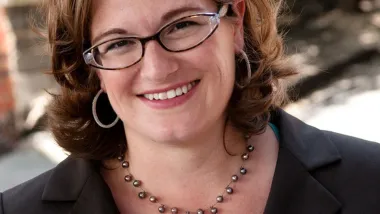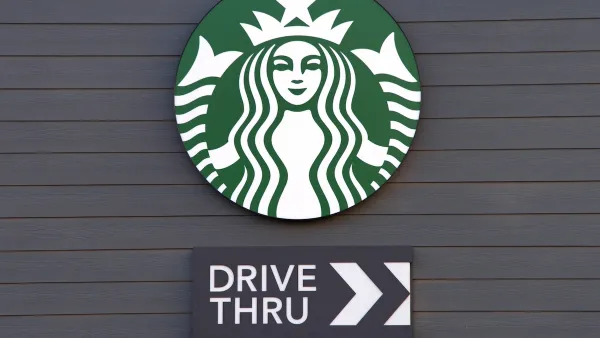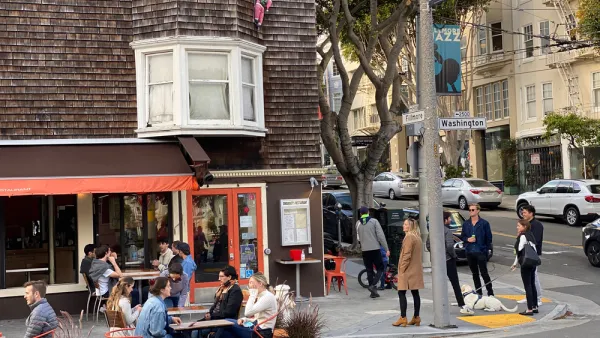Starbucks stores have seen a lot of protests. Due to its international brand recognition, the chain became an easy mark for activists looking to draw media attention to concerns from genetic engineering to union busting, from store placements in historically sensitive locations to the company’s opposition to Ethiopia’s application to trademark three types of coffee.
Starbucks
stores have seen a lot of protests. Due to its international brand recognition,
the chain became an easy mark for activists looking to draw media attention to
concerns from genetic
engineering to union busting,
from store placements in
historically sensitive locations to the
company's opposition to Ethiopia's application to trademark three types of
coffee. Citizens, activists, and planners engaged zoning overlays,
preservation districts, and other tools of local planning in dozens if not
hundreds of cities and towns where residents bemoaned the chain's role in the erosion
of unique local character. Starbucks' seemingly never-ending expansion was the
subject of ridicule
and satire. Starbucks
seemed like a never-ending font of ire and a butt of perpetual jokes.
That's
why I can't quite wrap my head around the grassroots (and quite sentimental) "save our starbucks"
movement that has emerged in response to announced plans to close around 600
stores.
From
Newark
to Knoxville,
customers, city planners, neighborhood activists, and mayors are asking the
company to reconsider plans to close the locations. (Generally speaking, Starbucks
is not slating its airport locations for closure. These stores, rather than
being well-loved, are at least broadly considered a vast improvement over the
airport bars with scalded coffee and perma-stale Danish that they replaced.)
It
seems that Starbucks has come to represent progress for a neighborhood. Beyond initial
concerns that the stores would simply draw a more gentrified clientele, the
stores have become symbols for each neighborhood or city's appearance on the
international map, as if the threat of closure will send area residents and patrons
stumbling back into oblivion. The Starbucks stores move into a neighborhood as
the check-cashing businesses, the liquor and adult video stores, and the fried-food-through-bullet-proof-glass
stores move out. (Indeed, here's an
advertisement for the sale of a check-cashing business that lists among its
unique attributes that it is located in the same shopping center as a Starbucks.)
Like the Guggenheim Museum was for Bilbao, Starbucks has symbolized the moment
of "arrival" for towns in plains states, long-downtrodden neighborhoods in rust
belt cities, and previously center-less suburbs of the Sunbelt states.
The
reasons for the Starbucks closures are varied. In some markets, Starbucks faces
stiff competition from locally
or regionally owned competitors. In other parts of the country with low population,
analysts have surmised that the chain "expanded
before some markets were ready." In several markets, Starbucks faces
heightened competition from other international chains like Dunkin' Donuts (who
has designed a new
store prototype with fancier finishes).
There
has been a small, but growing realization for several years Starbucks may not
be all bad for local businesses. Indeed, independently owned coffee shops have
seen exceptionally good business in the past five years, nationwide. A lot of
this is due to Starbucks' success at bringing an Italian-originated coffee bar
culture to the U.S. (When Howard Schultz became President & CEO of Starbucks
in 1987, he travelled to Italy and was enraptured by the jovial atmosphere of
Italy's espresso bars. He exported the concept of coffee shop as social space,
created a franchise-able interior decoration scheme that complemented the
concept, and hired skilled real estate experts to lead the charge of spreading
the stores across the land.) In 2007, Slate's
Taylor Clark spoke with a former
Starbucks real estate specialist and concluded that despite the growth of
independently-owned coffee shops, "Starbucks is actually trying to be ruthless in
its store placements; it wants those independents out of the way, and it
frequently succeeds at displacing them through other means, such as buying a
mom and pop's lease or intimidating them into selling out."
Local
planners and their booster allies shouldn't shed too many tears about a
Starbucks closure or two (or even 13 as proposed in Las Vegas). The company,
like so many others, found a good thing in rapid expansion plans and then
failed to correctly identify when the trend had ended before they had over-extended
and their competition had learned the lessons as well. Planners should rise
above the "responding" level and examine behaviors in the areas that are losing
Starbucks to identify the next trends. Maybe it's another coffee shop. Perhaps
there is even room to learn from Architect Magazine's design competition
for a "Starbucks of the Future." Study up on trends research like that on mobility hubs
coming out of Center for Advancing Research and Solutions for Society at the
University of Michigan. And if you still feel sentimental about losing the
Starbucks, maybe you can meet up with this guy for part of his
ambitious journey to visit every Starbucks in the world.

National Parks Layoffs Will Cause Communities to Lose Billions
Thousands of essential park workers were laid off this week, just before the busy spring break season.

Retro-silient?: America’s First “Eco-burb,” The Woodlands Turns 50
A master-planned community north of Houston offers lessons on green infrastructure and resilient design, but falls short of its founder’s lofty affordability and walkability goals.

Delivering for America Plan Will Downgrade Mail Service in at Least 49.5 Percent of Zip Codes
Republican and Democrat lawmakers criticize the plan for its disproportionate negative impact on rural communities.

Test News Post 1
This is a summary

Test News Headline 46
Test for the image on the front page.

Balancing Bombs and Butterflies: How the National Guard Protects a Rare Species
The National Guard at Fort Indiantown Gap uses GIS technology and land management strategies to balance military training with conservation efforts, ensuring the survival of the rare eastern regal fritillary butterfly.
Urban Design for Planners 1: Software Tools
This six-course series explores essential urban design concepts using open source software and equips planners with the tools they need to participate fully in the urban design process.
Planning for Universal Design
Learn the tools for implementing Universal Design in planning regulations.
EMC Planning Group, Inc.
Planetizen
Planetizen
Mpact (formerly Rail~Volution)
Great Falls Development Authority, Inc.
HUDs Office of Policy Development and Research
NYU Wagner Graduate School of Public Service






























